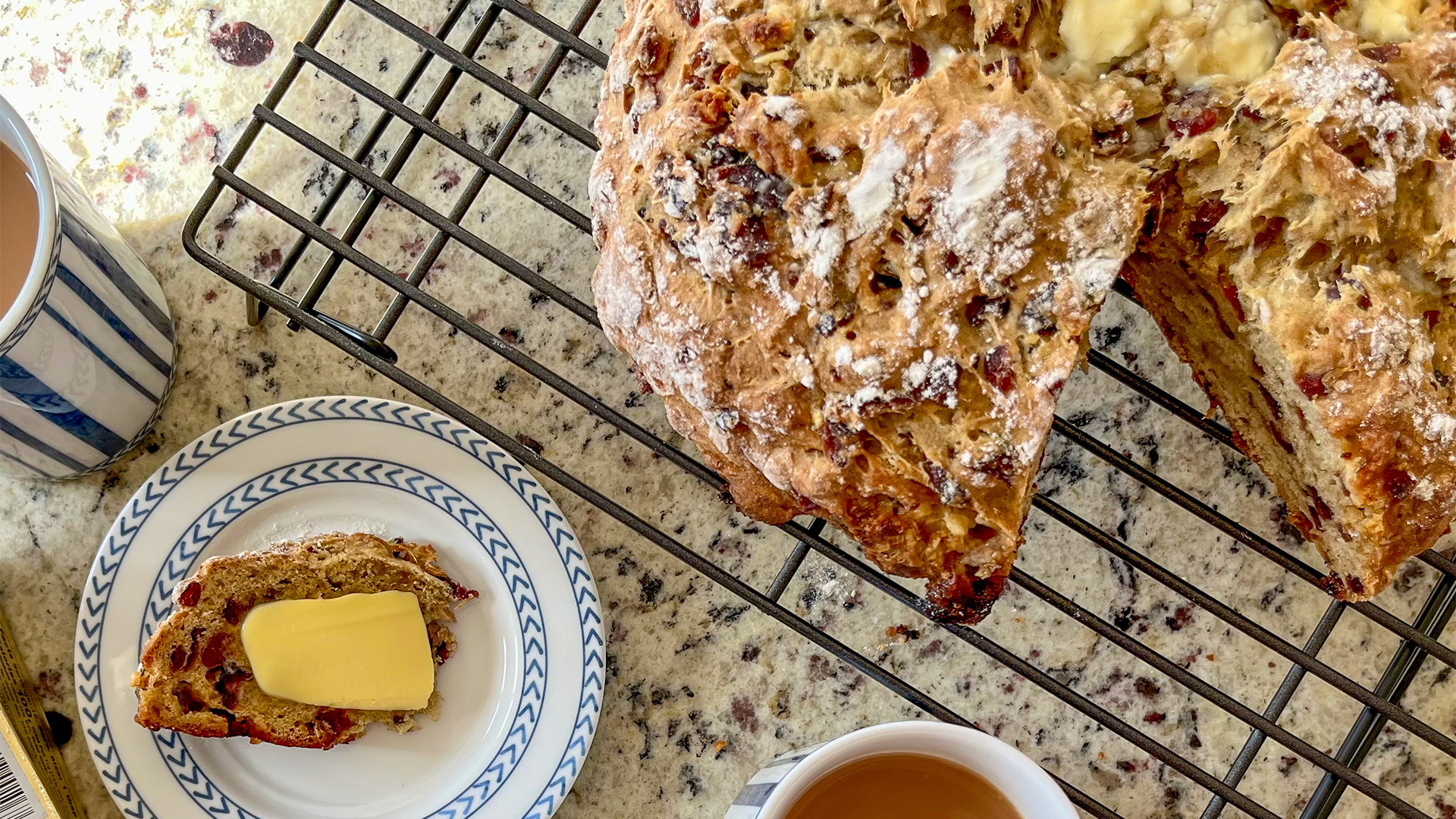But what if caraway wasn’t part and parcel of Irish soda bread? I was intrigued by the Orange-Cranberry Soda Bread we adapted from London’s Luminary Bakery. The first time I read through the recipe, I actually scoffed. There was no way an eight-ingredient recipe would deliver a tender, moist, scone-like bake... with zero added sugar, eggs or butter in the dough.
Well, sometimes it’s fun being proved wrong. Our recipe turns out a loaf that’s appropriately rustic and hearty on the outside, with an unexpectedly rich, plush crumb inside. Orange zest perfumes the dough, while sweetened dried cranberries and white chocolate round out the flavors. The whole thing is balanced, just-sweet-enough and utterly craveable. It might seem like sorcery, but baking soda and buttermilk make the magic.
Making the bread is relatively straightforward: Mix your dry ingredients, add your wet ones and handle everything as little as possible before a short bake. If you’re organized, the dump-and-stir recipe comes together quickly—90 minutes tops, not including cooling time.
Soda bread gets its name from its leavening ingredient—the quick bread rises from the use of baking soda, or sodium bicarbonate, instead of yeast. It’s a rustic, hearty bake. Everything happens in a single bowl, then on a sheet tray. No frilly egg washes required.
The loaf may be named for baking soda, but the hero of the recipe is buttermilk. Buttermilk’s tartness comes from lactic acid, which works in soda bread’s favor in two ways: It keeps gluten production low—with none of the long strands you’d see in a kneaded, yeasted loaf that typically lend structure and chew to bread—and it reacts with the baking soda to create a lighter, airier crumb. Think of the vinegar and baking soda volcanoes from your grade school days; the same concept applies.
Zest First!
A simple tip, but any time you’re asked to zest and juice a piece of citrus, zest before you juice, no matter which comes first in the recipe. It’s awkward trying to zest a flat, empty half of an orange. Set your tablespoon of orange zest aside before squeezing the juice required for hydrating the dried cranberries. (Side note: I finally broke the trusty microplane grater I’ve used for some 15-odd years. I’m replacing it with this one.)
Don’t skip hydrating the cranberries. The plumped up dry fruit loses some of its plasticky quality and gets infused with warm, sunny flavor.
Use Your Scale
I will shout this from the rooftops as long as I bake: Weigh. Your. Ingredients! A digital scale can be as extravagant or affordable as you want, but it’s a necessity. Accurate quantities are more than half the battle when texture is a primary consideration, especially when it comes to flour; we use two types for this recipe. There is too much variation in measuring with cups—are you spooning it into your cup or dipping the cup into the storage container? How densely packed is the flour? Measuring by mass instead of volume will genuinely make the difference between a fluffy soda bread and a brick.
And don’t even get me started on using liquid measuring cups for dry ingredients and vice versa. It’s just not as accurate. Don’t do it.
Don’t Skip the White Chocolate
I’m in my white chocolate era. I used to think it was too sweet, but now I’m putting chunks or shavings in more desserts: The good quality stuff plays nicely off of tangy citrus or stone fruit, coconut and dried fruit. So versatile.
Some of you might be tempted to replace the white chocolate with something darker, but please try the recipe as written first. The creamy white chocolate balances the tartness of the cranberries without stealing focus and gives the bread a boost of sweetness. ((The bits caramelized of white chocolate around the edges are to die for.) Since you don’t need perfectly uniform pieces, start the chopping process with a few good whacks on the counter or with a rolling pin. The job is halfway done before you even unwrap the bar.
You Need a Bench Scraper
Once your wet and dry ingredients are combined, the resulting dough will be wetter than you think—mine was, when I turned the shaggy, just-combined mixture out onto my floured counter. Every instinct in me wanted to knead. You might feel the same. Resist that instinct.
This recipe is only eight ingredients, and it hinges on handling them as little as possible. That’s how we achieve the plush, scone-like crumb that makes this unexpected soda bread worth it. So take a bench scraper, slide it under your dough and fold. Do this just enough for everything to come together, before moving the soda bread to your prepared baking sheet.
How to Serve and Store
My preferred way to serve any version of soda bread is warmed up with a veritable slab of salted Irish butter—Kerrygold, of course—or cheese, something nutty and sharp like Dubliner. The bread is best the day of baking. I double-wrapped most of my loaf in aluminum foil and stored it in a Ziploc bag, but it was still noticeably drier the next day; easily fixed with toasting and a generous slather of butter.

Join the conversation on Facebook, Instagram, TikTok and Pinterest.
And if you're looking for more Milk Street, check out our livestream cooking classes with our favorite chefs, home cooks and friends for global recipes, cooking methods and more.



